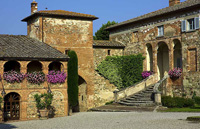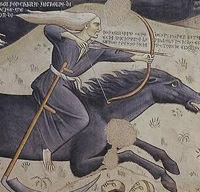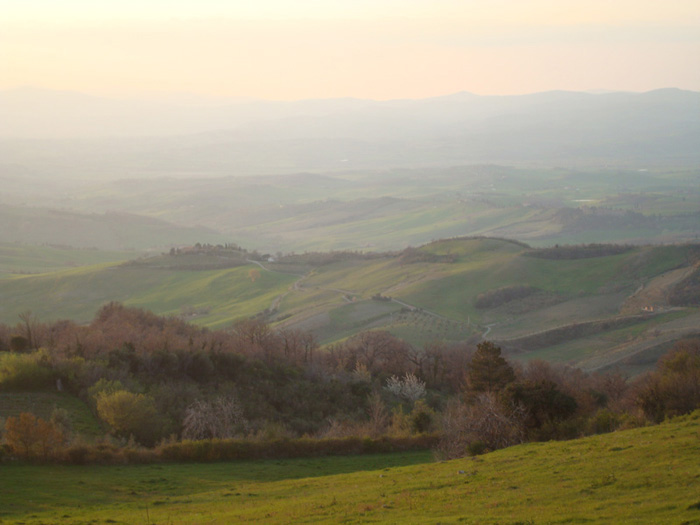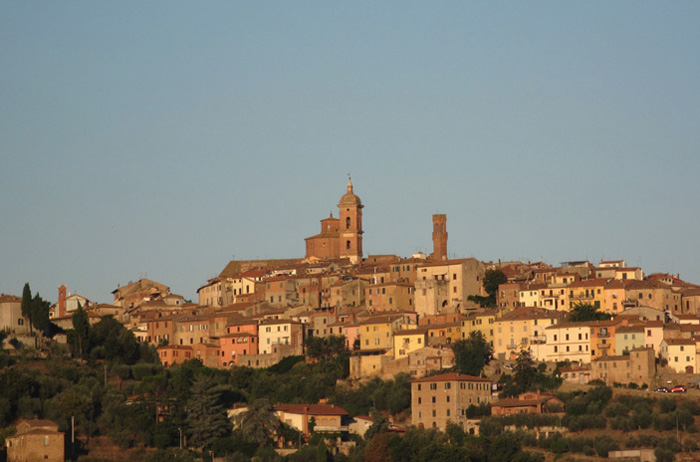 |
|
| I T |
Sinalunga |
Sinalunga |
Sinalunga is a typical hill settlement of probable Etruscan origin. The town-planning, that’s still so peculiar of Lucignano historical heart, dates back to 1200, and developed all around the original stronghold. Even nowadays the pattern of concentric rings, linked by narrow lanes, is perfectly preserved.over the years was developed and extended towards Valdichiana. It has civil and religious buildings of considerable beauty, one of the oldest being the Romanesque parish church of San Pietro Mensulas, con all’interno due cippi sepolcrali di epoca romana. Da visitare anche la Chiesa di San Martino with works by Girolamo del Pacchia. Civil buildings of great interest include the mid 14th century Palazzo Pretoriowhose walls bear numerous coats-of-arms of Podestas from the period of Sienese rule and others of the Medici; the mid 18th century Ciro Theatre and the antiquariuman exhibition of Etruscan finds and a precious painting by Domeni Beccafumi. Sinalunga eceived the Italian Orange Flag award for sustainable tourism. The Orange Flag is the tourism quality mark yearly awarded by the Italian Touring Club and dedicated to small inland villages which are distinguished by landscape conservation, welcoming atmosphere, promotion of cultural heritage, quality of accommodations and local products.
|
| Main sights Collegiata di San Martino (16th century), built from 1568 over the ancient castle. The interior, on the Latin cross, has works by Benvenuto di Giovanni, Il Sodoma and Rutilio Manetti. Palazzo Pretorio, built between 1337-1346. It was the centre of the civil power in the town, as attested by the podestà and Medici crests on its facade. Church of Santa Lucia (erected in 1278), now used as auditorium. Church of Santa Croce (15th century). It houses the Wedding of the Virgin by Luca Signorelli. |
||||
| Church of San Pietro ad Mensulas, built in the 4th century on a pre-existing Roman edifice, probably the main station on the Via Cassia. | ||||
| Torrita di Siena Torrita di Siena is located about 40 km southeast of Siena and about 17 km north of Pienza. The most important event in Torrita di Siena is the "Palio dei Somari", a race among donkeys, the Sunday after March 19th (Torrita's patron saint). The eight districts in which the town is divided compete against each other with the donkeys assigned each by a drawing.The race takes place in a place called Gioco del Pallone, just outside the city walls. Sights and Attractions: Church of Triano • Church of Madonna dell'Olivo • Church of Madonna delle Fonti a Giano • Church of Madonna delle Nevi • Church of Santissima Annunziata • Church of St. Flora e Lucilla • Church of Santa Croce • Collegiate church of Saints Martino e Costanzo. |
||||
| Fattoria l'Amorosa |
||||
| La Fattoria l'Amorosa è un complesso abitativo che si trova nel territorio del comune di Sinalunga. Sorta in epoca medievale su un territorio già abitato nei secoli della Civiltà etrusca e in Età romana, trova la sua prima citazione nell'affresco trecentesco di Lippo Vanni in ricordo della Vittoria dei senesi nella battaglia di Val di Chiana, opera conservata a Siena nella Sala del Mappamondo, compresa all'interno del Museo civico del Palazzo Pubblico (Siena). La proprietà delle strutture è stata in origine della famiglia Chigi-Saracini, per poi passare a quella dei Piccolomini e dei Pannillini. Nel XVIII secolo ci perviene come una vasta tenuta espansa nel tempo dotata di granaio, stalla, cantina, ma anche di un'osteria, di una scuola elementare e di una chiesa che, solo a partire dalla prima metà del XIX secolo, ha dato luogo ad una ricca comunità parrocchiale. Negli ultimi anni ospita una struttura ricettiva. Fattoria l'Amorosa | Sinalunga Cappella di San Michele alla Fratta |
||||
| La Fratta, a historic Val di Chiana farm, dates back to the 12th Century with the first official Acts dating back to 1208. In 1520 the farm was redesigned under the direction of Baldassarre Peruzzi. He built among others the main villa and the church which today still houses a Sodoma fresco. The monumental structure of the church annexed to the farm at Fratta appears quite in contrast with its isolated and fully rural location. Its architecture almost possesses the characteristics of an aulic and noble temple , that it’s certainly justified by the fact that the chapel has belonged to an illustrious tradition of noble families that have lived and still live in the villa in the center of the vast surrounding estate. A magnificent altar dominates the back wall, surrounded by a classical style niche, that strongly reminds us of the 17th century chapels , built in the lateral naves of the most illustrious of the Sienese Churches, the Cathedral of the Assumption. |
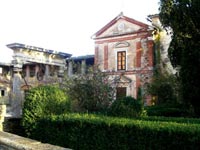 |
|||
| Pieve di San Pietro ad Mensulas |
||||
| The Parish Church of San Pietro Ad Mensulas is in Sinalunga in the province of Siena, and is part of the Diocese of Montepulciano - Chiusi - Pienza. The urban area at the foot of the hill is called Parish of Sinalunga for the presence of the Church of San Pietro Ad Mensulas, being one of the seven Churches founded by St. Donato around 1300-1330. Studying the Peutingeriana Table, an old military map showing the streets of ancient Rome, it is clear that the Church of San Pietro Ad Mensulas is in the area along the Cassia Road (Via Cassia), between Chiusi and Siena. The paper indicates that there was a coaching inn or a village, not knowing how big and important it was. During 1500, the Church of San Pietro Ad Mensulas, located on the road Chiusi-Siena, to the branching point for Arezzo, it could develop a major urban settlement, but advances in the marsh of the Valdichiana (Chiana Valley) discouraged new settlements and the inhabitants of Sinalunga preferred to move to the hill. The Parish Church of San Pietro Ad Mensulas has the plant of the basilica in romanesque style, with three naves separated by square pillars and the wooden roof. |
||||
| Monte San Savino is located in a panoramic position on the top of a hill dominating the valley of the river Esse and preserves some precious buildings designed by the architect and sculptor Sansovino, who was born here. The Loggia dei Mercanti is marvellous, hold by five arcades with Corinthian capitals and lined with precious palaces. Also visit the Palazzo Comunale, built by Giulinao da Sangallo Senior, with a arcade courtyard and a nice garden. In the Rocca del Cassero you can visit the Museo Comunale della Ceramica Poplare and is also worth to stop by the nearby Chiesa di Santa Chiara, where you can admire the works by Sansovino and the Robbia school. Not far from Monte San Savino, the marvellous fortress-village of Gargonza, which today is used for congresses and residences. Gargonza is located on the panoramic hill and is a very suggestive site thanks to the Tuscan medieval architecture which is well-preserved. Entering the portal from the 13th century you reach the delicious square with the Chiesa dei Santi Tiburzio e Susanna. |
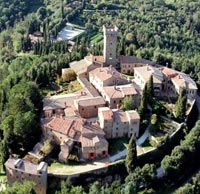 |
|||
| Lucignano sits on the ridge of Palazzuolo’s heights, in the district of Arezzo. Several religious buildings stand inside the walls, amid which the outstanding feature is St.Michael Archangel’s Collegiate church, erected in XVI century as an ideal implementation of the town, atop of the hill, on the spot already taken by the castle. Rich in Renaissance art, Lucignano is a medieval village with a remarkable layout. The ancient city walls still partly surround the historical centre of the town, where the Collegiate church of San Michele is to be admired. The late-16th century church houses a fresco by Matteo Rosselli and wooden sculptures dating back to the 15th century. The 16th-century Palazzo comunale houses the Civic museum, where works of artists of the Sienese school of painting that flourished in the 14th and 15th centuries are to be admired, along with a Madonna by Luca Signorelli and the so-called Albero di San Francesco (Saint Francis` Tree), a reliquiary by Ugolino di Vieri. Particularly interesting is also the church of San Francesco, dating back to the 13th century, with a Romanesque façade and a Gothic portal. The walls of the church are decorated with frescoes by Bartolo di Fredi and Sienese painters of the 14th and 15th centuries. Not far from the centre of Lucignano you find the Fortezza Medicea and the Santuario della Madonna delle Querce, a building from the second part of the 16th century. The Renaissance sanctuary of the Madonna delle Querce, a few kilometers outside of Lucignano, was probably designed by Vasari. The interior is attributed to Giuliano da Sangallo.
|
||||
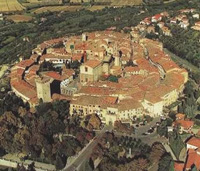 |
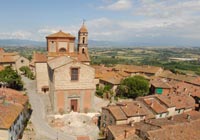 |
 |
||
Lucignano, ne of the most interesting examples of medieval town planning for his elliptical structure based on concentric rings
|
Collegiata di San Michele Arcangelo, Lucignano | Chiesa di San Francesco | ||
| Annexed to the Town Hall is the church of San Francesco, a fine example of gothic Franciscan basilican architecture with the floor plan in the shape of an Egyptian cross. The construction was probably started in 1248 and finished in 1289. The high and luminous façade is built of travertine stone and sandstone and has a large circular window framed in grey sandstone. |
||||
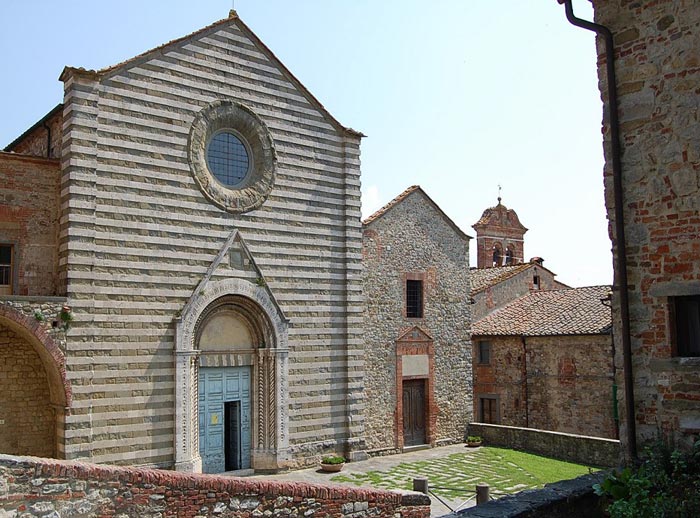 |
||||
La chiesa di San Francesco, Lucignano |
||||
| The most scenographic square in Lucignano, St.Francis’, enriched by the homonymous Chiesa di San Francesco, with its Romanic façade built in white and grey stone layers, with a Gothic gate and a rose-window. The church of San Francesco has numerous beautiful frescoes and there is a museum close by the church. Originally the church walls were completely frescoed but only fragments remain. Attributed to Bartolo di Fredi and Taddeo di Bartolo, they show moments in the life of Saint Francis. Il Trionfo della Morte, the Triumph of Death, is the title of the splendid fresco situated on the wall above the first altar on the right hand side of the nave. It shows the precariousness of human life on earth. |
||||
| Foiano della Chiana is a big town located on the top of the hills which surround the river Chiana and features a characteristic historical centre with an egg-shaped structure and red brick houses. In the centre you can visit the Palazzo Comunale, founded in the 14th century, and the Palazzo delle Logge, built in the 16th century for th Medici family as a hunting residence. Also take a look at the Chiesa della Santissima Trinità, with the characteristic dome decorated with polychrome majolica, and the Chiesa di Santa Maria della Fraternità, from the 16th century. In the square with the same name you find the Collegiata di San Martino, built between the 16th and the end of the 18th century. It features the Madonna della Cintola, attributed to Andrea della Robbia. Also interesting is the Chiesa dei Santi Domenico e Michele Arcangelo, a building from the 15th century dominated by a brick bell-tower. Just outside the town you ought to see the Chiesa di San Francesco, built at the end of the 15th century and houses a big altar-piece by Andrea della Robbia. The carnival of Foiano is very famous thanks to its unique and beautiful allegorical wagons which can compete with the ones in Viareggio. The carnival tradition goes back to 1866. |
||||
| Sinalunga map |
||
|
View Larger Map |
||
|
||
|
||
Podere Santa Pia, situated in a particularly scenic valley, which overlooks on the hills around Scansano, a well-known town for its historical and gastronomical traditions |
||
A visit to Lucignano can begin with a walk around the well preserved ancient walls. There are four gates to the city; Porta San Giovanni, known as “porta di sotto” (lower gate), Porta San Giusto known as “porta di sopra” (higher gate), Porta Sant’Angelo and Porta Murata (walled gate) so called after it was blocked up sometime in the year 1500. Enter the old town by one of the gates, the town is planned along two main streets, one, the present day Via Matteotti, is called the rich road, the other, Via Roma, is called the poor road. The first, where the nobility built their homes, is wide and full of light, the second is characterized by smaller, poorer dwellings built by the lower classes. A series of roads leading off from the main roads, form an intricate labyrinth taking you to the top of the town, the Town Hall, (Palazzo Comunale) the church of San Francesco and the Collegiate. The building of the Town Hall (Palazzo Pretorio), was started around 1200 and later completed by the Florentines. The main façade, facing Piazza del Tribunale, is covered by numerous coat of arms and memorial plaques showing the symbols of the various chief magistrates. Of particular interest is the Sala della Cancelleria, ancient seat of the local law court. The frescoes on the ceiling are by various 15th century Sienese artists and depict a series of illustrious personages. Some of the rooms on the second floor have fine frescoes with neoclassic subjects, painted around the year 1812 by the Milanese artist Luigi Ademollo. Palazzo Pretorio also houses the Civic Museum. Besides many notable paintings, the most important piece in the museum is undoubtedly the reliquary of San Francesco. Called Albero di Lucignano because of the six branches on each side making it resemble a tree, it is made of silver, gilded copper and enamel and was crafted between 1350 and 1476 by goldsmiths from Arezzo and Siena. It is undoubtedly one of the finest examples of Italian Goldsmith’s art. Annexed to the Town Hall is the church of San Francesco, a fine example of gothic Franciscan basilican architecture with the floor plan in the shape of an Egyptian cross. The construction was probably started in 1248 and finished in 1289. The high and luminous façade is built of travertine stone and sandstone and has a large circular window framed in grey sandstone. Originally the church walls were completely frescoed but only fragments remain. Attributed to Bartolo di Fredi and Taddeo di Bartolo, they show moments in the life of Saint Francis. Il Trionfo della Morte, the Triumph of Death, is the title of the splendid fresco situated on the wall above the first altar on the right hand side of the nave. It shows the precariousness of human life on earth. The church is set amongst a group of buildings, the Oratory of Corpus Domini, the Town Hall, the Monasteries of San Francesco and Santa Margherita, the church of the Crucifix and the Tower delle Monache. The left wall of the Collegiate faces onto Piazza del Tribunale but the façade is in via Rossini. The church was built in the shape of the Latin cross and the vestry, bell tower and rectory were added later. The façade is in two parts. The magnificent door is topped by a tympanum with a carved lily in the centre. The splendid flight of steps leading to the church is made of travertine stone and repeats the oval form of the town plan. Inside there are 17th century altars, paintings by Gemignani di Pistoia, Porta, Rosselli and Giovanni da Sangiovanni and a dramatic high altar. |
||
Val di Chiana - Hills and vineyeards from Torrita di Siena This itinerary loops aournd the hills and the vineyards of the Val di Chiana, passing through places like Montefollonico, a small mid-evil hamlet as well as Montepulciano which merits a detailed visit. You can also get to Torrita di Siena by train on the rail line Chiusi Scalo- Siena. |
||

